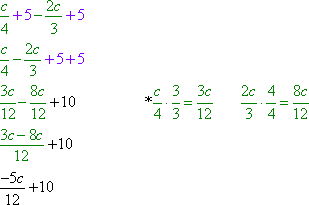POLYNOMIALS
 |
Unit Overview
This unit is an introduction to polynomials. In this unit you, will learn how to add and subtract polynomials. This concept will be expanded upon in future units and is very important to understand.
Polynomials
In the previous unit, you learned about monomials. In this unit, we are going to combine monomials with addition and subtraction and identify them with other names.
You have learned that a number, 3, a variable, x, or a product of a number and variable(s), 5mn, are called monomials. At this point, it should be mentioned that to be considered a monomial, a variable cannot have a negative exponent or appear in the denominator of a rational number.
For example, the following are not monomials: x–4 and
In this unit you, will be working with expressions like the following:
5m – 2 |
4x2 + 7x – 3 |
–5a2b3 + |
Each of these is a sum or difference of monomials called a polynomial.
| Special Names of Some Polynomials Each monomial within a polynomial is called a term. A polynomial with exactly two terms is called a binomial and a polynomial with exactly three terms is called a trinomial.
Recall that the numerical factor of a monomial is called the coefficient. In the term, –2y3 y, –2 is the coefficient. |
Example #5: Identify the terms and give the coefficient of each term.
|
![]() What are the coefficents of each of the variable terms in 7y3 + 4y2 – 9y + 5?
What are the coefficents of each of the variable terms in 7y3 + 4y2 – 9y + 5?
7, 4, and –9
"Click here" to check the answer.
Example #6: A local cell phone company uses the following expression when calculating cell phone charges. Interpret what each part of this expression may represent using correct mathematical terminology.
0.20 is the coefficient of the expression 0.20t of which 0.20 and t are factors. The number of text messages could be represented by t. |
 |
| Simplifying Polynomials To simplify polynomials, we collect like terms. Recall that terms like 3xy2 and 7xy2, whose variable factors are exactly the same, are called like terms. To simplify like terms, we combine the coefficients.
In future units, it will be necessary to determine the degree of a term or polynomial; so, at this point, we will talk about the degree of terms and polynomials. The degree of a term is found by adding all the exponents of the variables. The degree of a polynomial is then determined by the highest degree of all its terms. |
| Finding the Degree of a Polynomial The degree of a polynomial is the highest degree of its terms. The degree of a term is the sum of the exponents of the variables that appear in it.
*Remember: The degree of a polynomial is determined by the highest degree that occurs in any one of its terms |
||||||||||||||||
![]() What is the degree of 7xy3 + 4x4y2 – 9xy + 5 ?
What is the degree of 7xy3 + 4x4y2 – 9xy + 5 ?
The degree is 6 based on the second term (4 + 2 = 6).
"Click here" to check the answer.
| Order of a Polynomial Polynomials are generally written in either descending order (largest to smallest) in terms of a variable or ascending order (smallest to largest).
|
![]() In terms of y, what is the order of –2x3y + 8x2y2 + 7xy3 – 9y4 ?
In terms of y, what is the order of –2x3y + 8x2y2 + 7xy3 – 9y4 ?
Ascending Order
"Click here" to check the answer.
Stop! Go to Questions #1-17 about this section, then return to continue on to the next section.
Adding Polynomials
We are going to add and subtract polynomials in the same way that we simplified expressions, by combining like terms. Follow along with the examples below.
Example #1: Find the sum: (6x – 5y) + (–7x + 3y).
|
Example #2: Find the sum
|
Example #3: Find the sum: (3x2 – 15) + (5x2 + 7x).
|
Example #4: Given the following square with sides of given length, find the perimeter by adding all of the sides.
The perimeter of the given rectangle is 12j + 4k. |
Example #5: Given the following triangle with sides of given length, find the perimeter by adding all of the sides.
The perimeter of the given rectangle is 4x2 + x. |
Stop! Go to Questions #18-24 about this section, then return to continue on to the next section.
Subtracting Polynomials
Subtracting polynomials is done with the same process as adding in the fact that you will combine like terms. Be very careful when subtracting a quantity to make sure you subtract each term within the quantity.
*It is very helpful to change all the signs of the quantity being subtracted, and then combine like terms. Follow along with the example below.
Example #1: Find the difference: (8t – 4s) – (3t – 5s).
|
Example #2: Find the difference:
|
Example #3: Find the difference: (5x4 + 3x2) – (6x4 –2x2).
|
Example #4: Find the difference: (–7m3 + 2m + 4) – (–2m3 – 4).
|
Are Polynomials Closed?
|
![]() Are polynomials closed under addition?
Are polynomials closed under addition?
Yes!
"Click here" to check the answer.
Now, consider subtraction of polynomials for closure. Look over the answers to the subtraction examples in this section of the content. When two polynomials are subtracted, will the result always be a polynomial?
![]() Are polynomials closed under subtraction?
Are polynomials closed under subtraction?
Again, Yes!
"Click here" to check the answer.
Stop! Go to Questions #25-37 to complete this unit.




